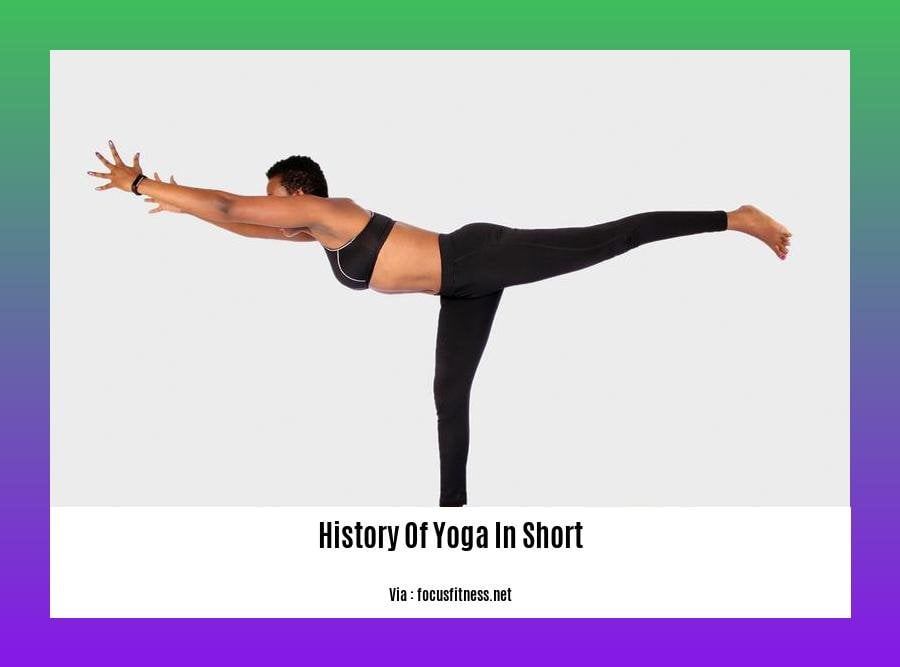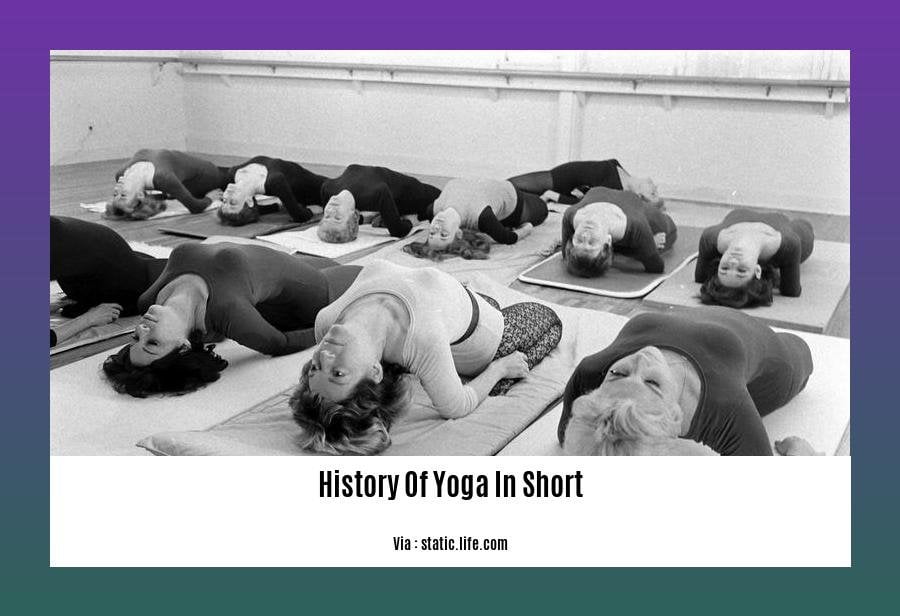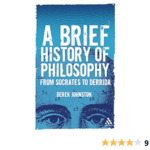Embark on a journey through time as we delve into the rich history of yoga, tracing its roots from ancient India to its global expansion. Discover the profound influence of The Vedas and Upanishads, meet Sage Patanjali, the father of modern yoga, and explore the harmonious union of sun and moon in Hatha Yoga. Witness the Bhagavad Gita’s profound impact on yoga philosophy, and prepare to be inspired by the transformative power of this ancient practice.
Key Takeaways:
The history of yoga is divided into periods of innovation, practice, and development.
Early Inception: Yoga is believed to have originated between 5,000-10,000 years ago in ancient India.
Vedic Yoga: The Vedic age took place in 2,500 – 1,500 BCE.
Classical Yoga: From 500 BCE to 800 CE, this period is considered the richest in yoga’s development.
Modern Yoga: Developed from the late 19th century onwards.
History of Yoga in Short

Yoga, an ancient practice originating in India, has a rich history that has left a profound impact on physical and mental well-being worldwide. Its evolution has been marked by innovation, exploration, and adaptation, spanning several distinct periods:
Early Inception
- Yoga’s roots can be traced back 5,000 to 10,000 years ago, with evidence suggesting its existence in ancient Indian civilizations.
- Early practices focused on meditation, breath control, and simple body movements.
Vedic Yoga
- During the Vedic age (2,500 – 1,500 BC), yoga began to take a more structured form, with the emergence of the Upanishads, philosophical texts that explored the relationship between the body and the mind.
- The concept of “Brahman,” the universal soul, became central to yoga practice.
Classical Yoga
- The classical period (500 BC to 800 AD) is considered the golden age of yoga, marked by the compilation of the Yoga Sutras of Patanjali.
- Patanjali systematized yoga into an eightfold path, addressing physical postures (asanas), breath control (pranayama), and mental focus (dhyana).
Modern Yoga
- From the late 19th century onwards, yoga spread beyond India, gaining popularity in the West.
- Modern yoga incorporates elements from traditional yoga, Western exercise, and physical therapy, resulting in diverse styles such as Hatha, Vinyasa, and Iyengar.
Throughout its history, yoga has evolved to address the diverse needs of practitioners, from spiritual seekers to those seeking physical fitness and well-being. Today, yoga is a global phenomenon, practiced by millions worldwide.
Want to explore the historical roots of yoga? Delve into the history of yoga timeline, which offers an in-depth journey through this ancient practice, from its early origins to its modern-day evolution.
If you have an appetite for history on a global scope, don’t miss the interactive timeline of world history, an engrossing tool that allows you to navigate through major historical events and periods from across the globe.
Curious about the viability of history as an optional subject for the UPSC exam? Explore our comprehensive analysis in is history a good optional for UPSC, where we delve into the benefits, challenges, and strategies for success in this popular choice.
Hatha Yoga: When the Sun and the Moon Intertwine
Hatha Yoga is a popular form of yoga that aims to achieve a balance between the ‘sun’ and ‘moon’ forces within an individual. These forces represent the opposing energies that exist in the body and mind, such as the active and passive, masculine and feminine, or sympathetic and parasympathetic nervous systems. Through physical postures, breathing exercises, and meditation, Hatha Yoga seeks to harmonize these energies, leading to a state of equilibrium and well-being.
Key Takeaways:
- Yoga’s origins can be traced back to ancient India, with the term first mentioned in the Rig Veda.
- Hatha Yoga focuses on achieving a balance between the opposing energies within the body and mind, using physical postures, breathing exercises, and meditation.
- The sun and moon forces in Hatha Yoga represent the active and passive, masculine and feminine, or sympathetic and parasympathetic nervous systems.
- Patanjali, known as the father of modern yoga, systematized yoga principles in the Patanjali Yoga Sutras, making yoga accessible to the general population.
A Deeper Dive into Hatha Yoga’s History and Evolution
Around 2,500 to 1,500 B.C., the Vedic age emerged, refining the practices of yoga. During this time, the Upanishads, philosophical texts discussing yoga, meditation, and the nature of the self, were composed. These texts laid the foundation for the later development of yoga.
In the 5th century B.C., the Bhagavad Gita, a sacred Hindu text, was written. The Bhagavad Gita contains teachings on yoga and the path to spiritual liberation. It emphasizes the importance of selfless action, devotion, and the cultivation of inner peace.
The history of yoga is marked by several significant figures who have contributed to its development and dissemination. One of the most notable figures is Patanjali, who lived around the 2nd century B.C. Patanjali systematized the teachings of yoga in his Yoga Sutras, a text that is considered the foundation of modern yoga.
Yoga continued to evolve during the medieval period (500-1500 A.D.), with the emergence of various yoga traditions and lineages. These traditions developed distinct approaches to yoga, emphasizing different aspects of the practice, such as physical postures, breathing techniques, and meditation.
In the late 19th and early 20th centuries, yoga began to spread to the West, primarily through the efforts of Indian teachers such as Swami Vivekananda and B.K.S. Iyengar. These teachers introduced yoga to Western audiences, adapting the practice to suit their cultural and physical needs.
Sources:
A Journey Through Time: Exploring the Rich History of Yoga
The History of Yoga
The Bhagavad Gita and Yoga

Yoga and The Bhagavad Gita are intertwined with a deep and rich history, guiding us on a transformative journey of self-discovery and spiritual evolution. Immerse yourself in the wisdom of these ancient texts as we delve into their profound significance in yoga practice and philosophy.
The Bhagavad Gita: A Timeless Wisdom
At the heart of the Mahabharata epic, a profound dialogue between Lord Krishna and Arjuna unveils the timeless wisdom of The Bhagavad Gita. This sacred text is revered not only as a spiritual guide but also as a philosophical treatise, offering invaluable insights into the essence of yoga.
The Bhagavad Gita unveils the intricate tapestry of yoga, weaving together profound philosophies and practical techniques, emphasizing the union of body, mind, and spirit.
Its teachings encompass the principles of karma yoga, bhakti yoga, jnana yoga, and raja yoga, providing a comprehensive roadmap for spiritual liberation.
The Bhagavad Gita resonates with the essence of yoga, guiding practitioners toward self-realization, liberation from suffering, and the ultimate union with the divine.
Yoga: A Journey of Transformation
Rooted in the ancient traditions of India, yoga is a holistic practice that encompasses physical postures, breathing exercises, and meditation. Its transformative power extends beyond mere physical well-being, encompassing mental, emotional, and spiritual dimensions.
Yoga originated in India around 5,000 years ago, with its roots deeply entwined with ancient philosophies and spiritual practices.
The Vedic texts, including the Upanishads, contain references to yoga, emphasizing its significance in achieving spiritual liberation and enlightenment.
Patanjali, a renowned yoga master, codified the principles of yoga in the Yoga Sutras, a seminal text that systematized and structured the practice.
The Bhagavad Gita and Yoga: A Synergistic Union
The Bhagavad Gita and yoga share a profound synergy, offering a comprehensive and harmonious approach to personal transformation.
The Bhagavad Gita provides the philosophical framework for yoga, illuminating the principles of selfless action, devotion, knowledge, and meditation, guiding practitioners toward spiritual enlightenment.
Yoga, in turn, serves as a practical embodiment of the teachings of The Bhagavad Gita, offering a systematic path for cultivating inner peace, self-awareness, and spiritual growth.
Together, The Bhagavad Gita and yoga form a powerful combination, empowering individuals to transcend their limitations, embrace their true nature, and attain a state of lasting inner peace and fulfillment.
Key Takeaways:
The Bhagavad Gita is a sacred text that offers philosophical and practical guidance for spiritual seekers.
Yoga is a holistic practice that originated in India, encompassing physical postures, breathing exercises, and meditation.
The Bhagavad Gita and yoga share a deep connection, with the Gita providing the philosophical framework and yoga offering the practical embodiment of its teachings.
The combination of The Bhagavad Gita and yoga provides a comprehensive path for self-transformation, leading to inner peace, self-awareness, and spiritual growth.
Citations:
- The History of Yoga – A Timeline From Inception To Present Day
- History of Yoga • Yoga Basics
FAQ
Q1: What are the Vedas and Upanishads, and how do they relate to yoga?
A1: The Vedas and Upanishads are ancient Indian texts that are considered fundamental to the philosophy and practice of yoga. They contain teachings on meditation, self-realization, and the nature of reality. The Upanishads, in particular, explore the concept of the Atman, or inner self, which is central to yoga philosophy.
Q2: Who is Sage Patanjali, and why is he considered the father of modern yoga?
A2: Sage Patanjali was a renowned yoga master who lived in India around the 2nd century BCE. He is credited with systematizing and codifying the principles of yoga into the Yoga Sutras, which is considered one of the foundational texts of yoga. Patanjali’s teachings emphasize the importance of physical postures (asanas), breathing exercises (pranayama), and meditation (dhyana) as a means to achieve spiritual liberation.
Q3: What is Hatha Yoga, and how does it relate to the sun and moon forces within an individual?
A3: Hatha Yoga is a form of yoga that focuses on physical postures (asanas), breathing exercises (pranayama), and meditation (dhyana). It aims to balance the opposing forces of the sun (yang) and moon (yin) within an individual. The sun represents the active, masculine energy, while the moon represents the receptive, feminine energy. Hatha Yoga practices aim to harmonize these two forces to achieve physical, mental, and spiritual balance.
Q4: How does the Bhagavad Gita relate to yoga, and what teachings does it offer?
A4: The Bhagavad Gita is an ancient Indian scripture that is part of the Hindu epic Mahabharata. It contains teachings on yoga, philosophy, and devotion. The Gita emphasizes the importance of selfless action (karma yoga), meditation (dhyana yoga), and devotion to God (bhakti yoga). It also explores the concept of the Atman, or inner self, and its relationship to the Supreme Being.
Q5: What are the main periods in the history of yoga, and how did they contribute to its evolution?
A5: The history of yoga can be divided into several periods, including the Pre-Vedic and Vedic period, the Pre-classical period, the Classical period, the Post-classical period, and the Modern period. Each period played a significant role in shaping the development of yoga. The Pre-Vedic and Vedic period laid the foundation with early practices and beliefs. The Pre-classical period saw the emergence of yoga as a more structured practice. The Classical period witnessed the systematization of yoga by Sage Patanjali and the development of Hatha Yoga. The Post-classical period saw the spread of yoga to different parts of the world, while the Modern period witnessed the globalization of yoga and its adaptation to contemporary lifestyles.












